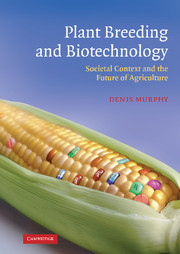Book contents
- Frontmatter
- Contents
- Preface
- Acknowledgements
- Using this book
- Nomenclature and terminology
- Abbreviations and glossary
- Introduction
- Part I The science of plant breeding
- Part II The societal context of plant breeding
- Part III Turmoil and transition: the legacy of the 1980s
- Part IV The agbiotech paradigm
- Part V Increasing global crop production: the new challenges
- Part VI Plant breeding in the twenty-first century
- 16 The future of international plant breeding
- 17 Rebalancing our approach to crop improvement
- 18 Where do we go from here?
- 19 Conclusions and recommendations
- Notes
- References
- Index
17 - Rebalancing our approach to crop improvement
Published online by Cambridge University Press: 07 May 2010
- Frontmatter
- Contents
- Preface
- Acknowledgements
- Using this book
- Nomenclature and terminology
- Abbreviations and glossary
- Introduction
- Part I The science of plant breeding
- Part II The societal context of plant breeding
- Part III Turmoil and transition: the legacy of the 1980s
- Part IV The agbiotech paradigm
- Part V Increasing global crop production: the new challenges
- Part VI Plant breeding in the twenty-first century
- 16 The future of international plant breeding
- 17 Rebalancing our approach to crop improvement
- 18 Where do we go from here?
- 19 Conclusions and recommendations
- Notes
- References
- Index
Summary
[Imagination] reveals itself in the balance or reconciliation of opposite or discordant qualities: of sameness, with difference; of the general, with the concrete; the idea, with the image …
Samuel Taylor Coleridge (1817) Biographia LiterariaIntroduction
In preceding chapters, we have followed some of the seismic shifts in the balance between public and private sector activities in plant breeding over the past few decades. While some developments have been positive, others have fuelled concerns about the overall direction of plant breeding research, particularly its future capacity to deliver on the primary mission of crop improvement. Two key priorities should be the revitalisation of the public sector and the re-empowerment of plant breeding as a valued and socially necessary scientific discipline. To achieve this, we must seek to re-establish those structural balances in plant research that have gone so seriously awry over the past few decades. For example, we should restore the balance between the following: the public and private sectors as they relate to agriculture; transgenic methods and non-transgenic variation enhancement plant breeding strategies; academic research and applied R&D in the plant sciences; and between pragmatic, public-good crop improvement, especially for developing countries, and the more inward-looking topical issues (such as the debate on GM crops) that currently preoccupy many richer industrialised nations. In this chapter, we will begin by discussing how to revitalise our much depleted public sector, and re-establish some of the balances within plant science in general.
- Type
- Chapter
- Information
- Plant Breeding and BiotechnologySocietal Context and the Future of Agriculture, pp. 264 - 275Publisher: Cambridge University PressPrint publication year: 2007



